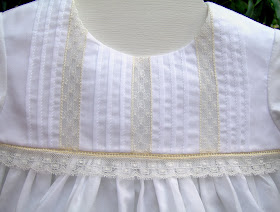 Even though the weather is still cold, the new issue of Sew Beautiful magazine, gave me hope that spring is just around the corner! As always, it is full of wonderful ideas and sewing tips.
Even though the weather is still cold, the new issue of Sew Beautiful magazine, gave me hope that spring is just around the corner! As always, it is full of wonderful ideas and sewing tips. What a nice surprise it was for me, to open the magazine and see Linda Richards original smocking design on my #114 Smocked Romper! I love the pale blue and green smocking that she did on the white romper, and the smocking design is included in the magazine. The #114 Smocked Romper includes sizes 2 - 5, and #134 is the same romper in sizes 3 month - 24 month.
What a nice surprise it was for me, to open the magazine and see Linda Richards original smocking design on my #114 Smocked Romper! I love the pale blue and green smocking that she did on the white romper, and the smocking design is included in the magazine. The #114 Smocked Romper includes sizes 2 - 5, and #134 is the same romper in sizes 3 month - 24 month. This romper, is the same style that I liked to dress my boys in over 25 years ago, and one that I look forward to using for my future grandchildren.


















































